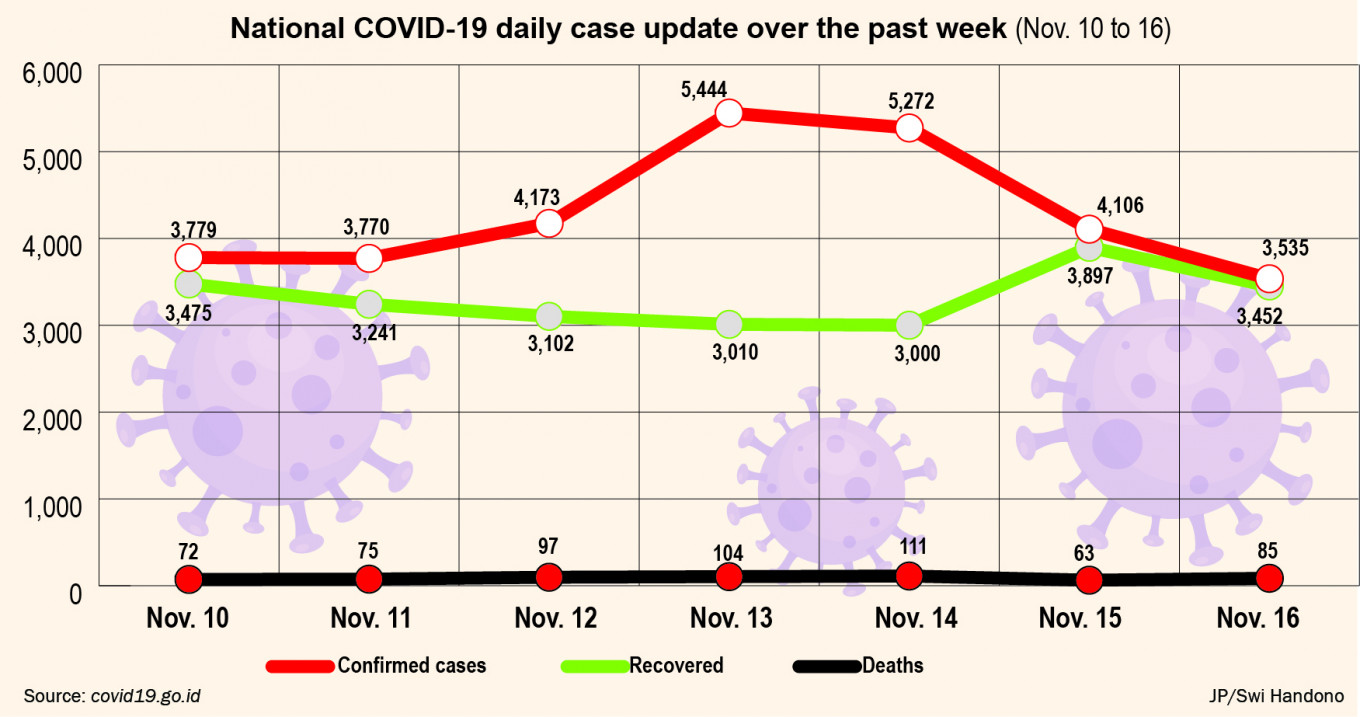Popular Reads
Top Results
Can't find what you're looking for?
View all search resultsPopular Reads
Top Results
Can't find what you're looking for?
View all search results[INSIGHT] Stop COVID-19 data blunders to save lives
On Dec. 3, the number of single-day COVID-19 cases in Indonesia rose to a record 8,369. The COVID-19 task force said this might have been caused by technical issues due to the inadequate system used to accumulate real-time data.
Change text size
Gift Premium Articles
to Anyone
On Dec. 3, the number of single-day COVID-19 cases in Indonesia rose to a record 8,369. The COVID-19 task force said this might have been caused by technical issues due to the inadequate system used to accumulate real-time data.
In Papua this meant that two weeks worth of cases – 1,755 – were counted as a daily figure. If the glitch was real, then Papua was supposed to have recorded 125 new cases on average per day.
This major data blunder has once again cast doubt on the reliability of government data on COVID-19 cases. During the pandemic, real-time data is crucial for the government as a benchmark for policy making, thereby helping it decide how to respond best and how to recover. Moreover, data-driven decisions are crucial for enforcing strict containment and social distancing measures, such as large-scale social restrictions (PSBB) in high-risk regions.
The different standards local governments apply in reporting new cases will lead to an incomplete view of the risks that the disease has brought to local governments and the national government. Some of the new cases were reported a few days late. Other local administrations even reported accumulated cases.
We have been handling COVID-19 for almost 10 months, so this data problem should no longer be tolerated. Hospitals and even citizens have relied on the data. As we are living in the middle of a pandemic wherein every hour a person might be infected, downplaying this matter might be the biggest reason why we have been unable to get COVID-19 under control. It is imperative that data standards are consistent so that the right decisions can be made.
Then, how do we solve these data blunders?
First, we need to realize that trying to make the data available is not enough. The government should also improve the transmission of this data from each health facility to the national level. Right now, many cases are reported by health facilities – including numbers of asymptomatic persons, patients under surveillance and people under monitoring.
However, the way the data is reported is still incomplete, and its quality varies enormously. For example, some health facilities report every day, others only every week. This delay causes missing information at the regional level and affects the immediate response from local governments. Therefore, the data's timeliness should have been treated with a little more caution to avoid gaps in data quality among regions and to increase the accuracy of data at the national level.
Second, it is crucial to have a single standard of presenting the data to the public. Merging all the numbers into thousands of rows in one big table is uncomfortable to read. People will have difficulty assessing and understanding the implications of vital information.
As the temptation to see relatives during the holiday season remains, people are wondering how risky it would be to travel. Numbers and graphs are extremely useful in displaying a large data set, but the readers may not easily understand them.
Illustrating this data with online maps can facilitate clear and effective communication of the potential dangers associated with the number of infections by area. We can visualize it like a weather map. If we display the risk as “rain” then the readers understand that they will get “wet”, or at least they will carry an umbrella as protection if they have to go out.
As a data provider, the government can tell the risks. Still, citizens should also understand whether the risks are worth taking. Therefore, drawing meaningful conclusions from frequent numbers on a digital map in a simple visual way can be an excellent tool for analyzing the spread of the virus. A map can help people visualize how the virus moves through the population within a specific density.
Some local governments have adopted mapping visualizations to elaborate the data, but they lack guidance explaining what should be put in place. Using a good map visualization to increase awareness can push people to become more cautious when they are engaging in activities that can increase transmission. Furthermore, the same level of understanding can help both the government and citizens make rapid decisions.
In conclusion, the government needs to understand that COVID-19 data is important to influence people's behavior. In the end, things are deeply dependent on how we, as a society, respond. Otherwise, this pandemic could get out of control next year.
-------
The writer is Master of Geomatics candidate at Delft University of Technology in the Netherlands, currently analyzing user experience for geographic information systems.










